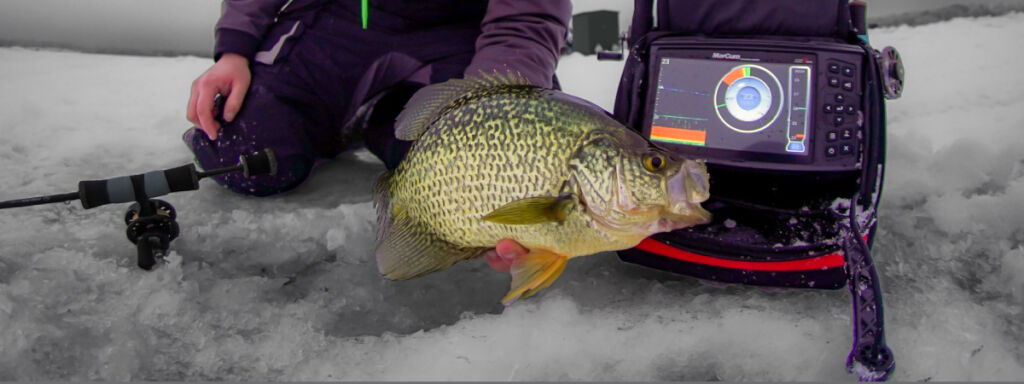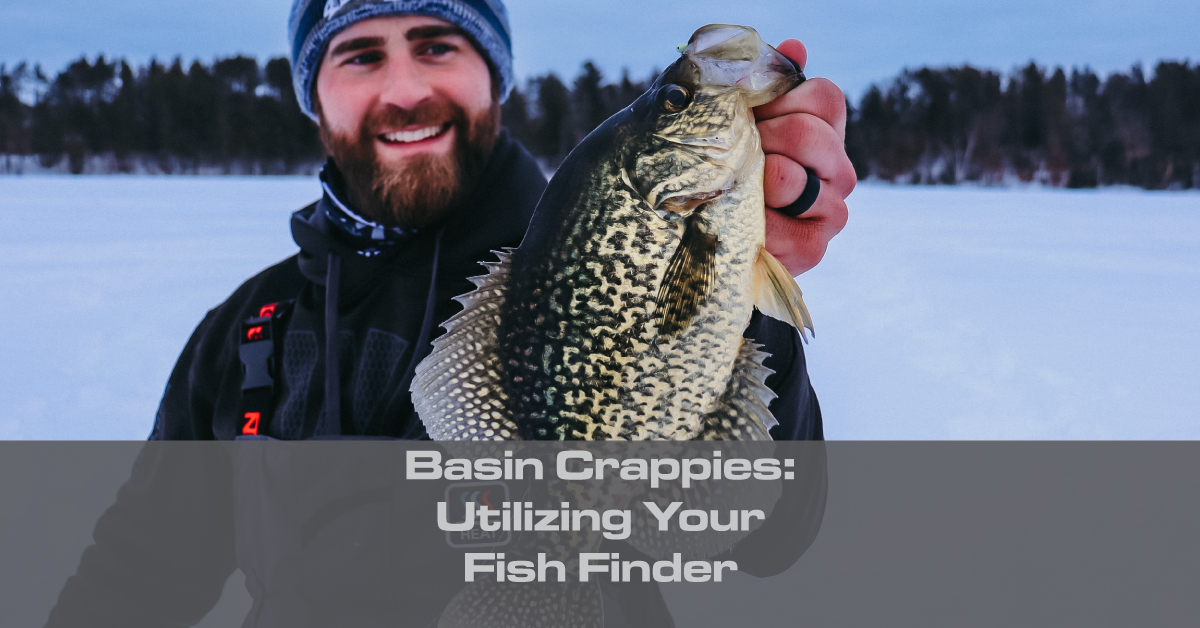Basin Crappies:
Utilizing your Fish Finder
It’s midwinter. Lakes are locked up with a solid layer of ice. Shanty towns dot the landscape – filled with anglers that are willing to trade long rods for those of a shorter variety. Panfish – crappies in particular – are some of the most targeted species throughout the hard water season. Knowing how to find them and which tools to use will ultimately make for a more successful day on the ice.
Location, Location, Location
In general, crappies are a relatively nomadic species and are constantly on the move. It’s not uncommon to locate them across countless types of structures within a body of water. Weeds, wood, rocks, and open basins are all equal opportunity employers when it comes to holding fish.
Crappies will continuously roam large expanses of a body of water in search of nourishment. Perhaps the most consistent bite throughout the winter months occurs in the main basin of the lake.
A typical Fall will drive schools of crappies from their summer haunts to the deeper portions of the lake, where the fish can often be found suspended throughout the water column. Predictable depths for winter crappies will range approximately 20-40 feet of water, although they can be found in much shallower or deeper locations depending on the lake.
Most relatively small, natural lakes share a similar pattern so replicating results can become second nature. These patterns and techniques related to winter crappies can also be applied to flowages and impoundments, although they may not prove to be as consistent.
On the Hunt
Knowing where to start the search for winter panfish is key to success on the ice. There are several resources available to the average angler that can help pinpoint crappie fishing locations. Sonar units with built-in mapping capabilities, like MarCum’s MX-7 GPS, help an ice fisherman locate the spot-on-the-spot.

Start the search in the deepest portion of the main lake basin. It is often most efficient to drill the first hole in the center of the deepest portion and work towards the closest edge of the basin. It’s not uncommon to find fish focusing on the steepest break or quickest change.
Drill a pattern of even spaced holes throughout the target area. It is a good practice to drill several holes ahead of time to allow for quick checking of holes. On heavily pressured lakes, basins will often become community holes. Focus on the outer edges to avoid traffic.
Prior to wetting a line, use your MarCum to determine if fish are present in the vicinity of the hole. Swing the transducer back and forth across the hole to determine if fish are nearby. This method can help determine which direction to proceed on the search.
If flashes are marked on your electronics in a certain area, proceed in that direction. Travel methodically from hole to hole until fish are found. If fish are nonexistent, keep drilling. It’s not uncommon for anglers to drill tens to hundreds of holes in a day on the ice.

Zooming & Detecting in Real Time
Electronics play a huge role in ice fishing success – but not all electronics are created equal. Open water electronics continue to trickle their way into the ice market, however, ice specific units, like MarCum’s fleet of flasher and sonar systems, have several features that make them markedly advantageous for chasing down roaming schools of crappies.
The zoom feature is an extremely useful tool for nearly all fish species. Many of the fish species that ice fishermen encounter relate to the bottom, or at least within the bottom portion of the water column. Crappies, however, are a different animal.
Unlike many other species, crappies can be both bottom-oriented or suspended at mid-range depths. Most basin-oriented crappies spend the winter months suspended throughout the water column. All of MarCum’s flasher and sonar systems feature zoom technology, and the majority feature their patented moveable zoom. This technology allows an angler to zoom in on any depth range – in turn providing the user with a crisper, clearer view of what’s happening at any specific depth range.
MarCum’s M1, or entry level model, strictly features bottom zoom. However, the M3 and M5 units feature moveable zoom with the option for 5 or 10 foot zoom windows. MarCum’s series of sonar systems (LX-7, LX-9, and MX-7GPS) feature even more options in turns of zoom capacities – including your choice of 5, 10, 20 and 40 foot zoom windows.

Another factor that influences fishing success relates to the ability to determine the number and size of fish that present. Enter the term target separation. Target separation refers to the distance required between targets for a flasher/sonar to recognize objects as individual objects. In other words, target separation allows you to discern one thing from another on your sonar display.
Basically, if a unit had 1 inch target separation and two fish were an inch or more apart, the unit could detect two fish. This is particularly valuable with schooling fish, like crappies – it’s not all that common to find just one crappie at a time. Revealing which fish are present, their size, and whether they are active, can help an angler to adjust their presentation for optimal results. MarCum’s line of flashers and sonar systems feature varying levels of target separation:
- M1 – 2 inches
- M3 – 1 inch
- M5 – ¾ inch
- LX-7 – ½ inch
- LX-9 – ½ inch
- MX-7GPS – ½ inch
Beyond target separation and moveable zoom, many MarCum ice units also feature dual beam transducers. The M5, LX-7, LX-9 and MX-7GPS feature dual beam transducers with both 8-degree and 20-degree cone angles. Having the capability to narrow or widen the cone angle has some very specific benefits.

When searching for roaming schools of crappies, the 20-degree angle provides a greater viewing area, which in turn makes finding fish that much easier. The 8-degree angle is useful for narrowing down the target and focusing on specific crappies in a school. It is also helpful for fishing in close proximity to others as it prevents interference between units.
One of the more overlooked features of ice specific flasher and sonar systems is their ability to read in real-time. Open water units operate in a different manner and as a result often have a lag. This immediate response is particularly beneficial in tough conditions when crappies are on the pickie side.
The real-time display provides an angler with instantaneous feedback regarding their presentation and how the fish are reacting to it. It allows a fisherman to make quick adjustments to their cadence or presentation, and coax unwilling participants into eating.
Basin crappies can provide some fast-paced action during the winter months. The toolbox is full when it comes to locating and catching fish on the ice. Put the proper tools to work and there’s a good chance to put some serious crappies topside this winter.










